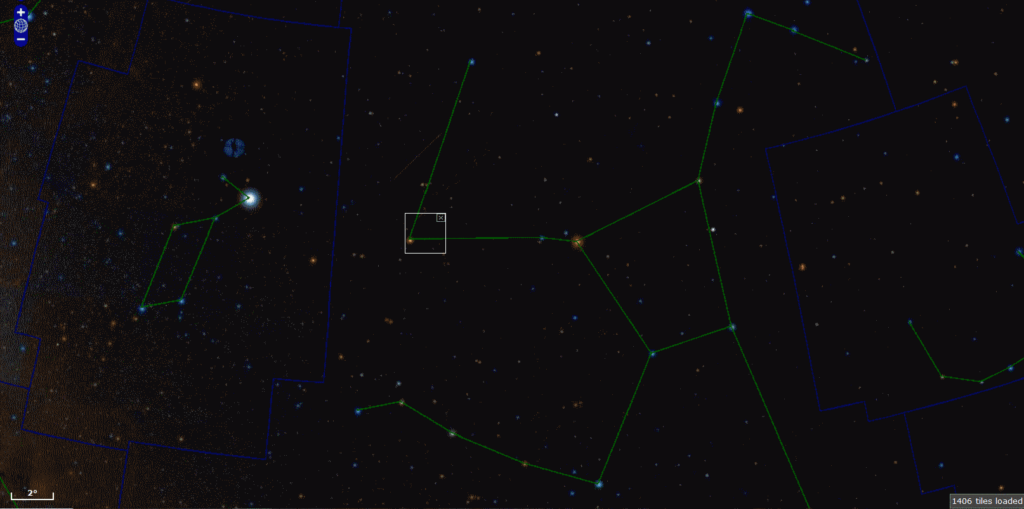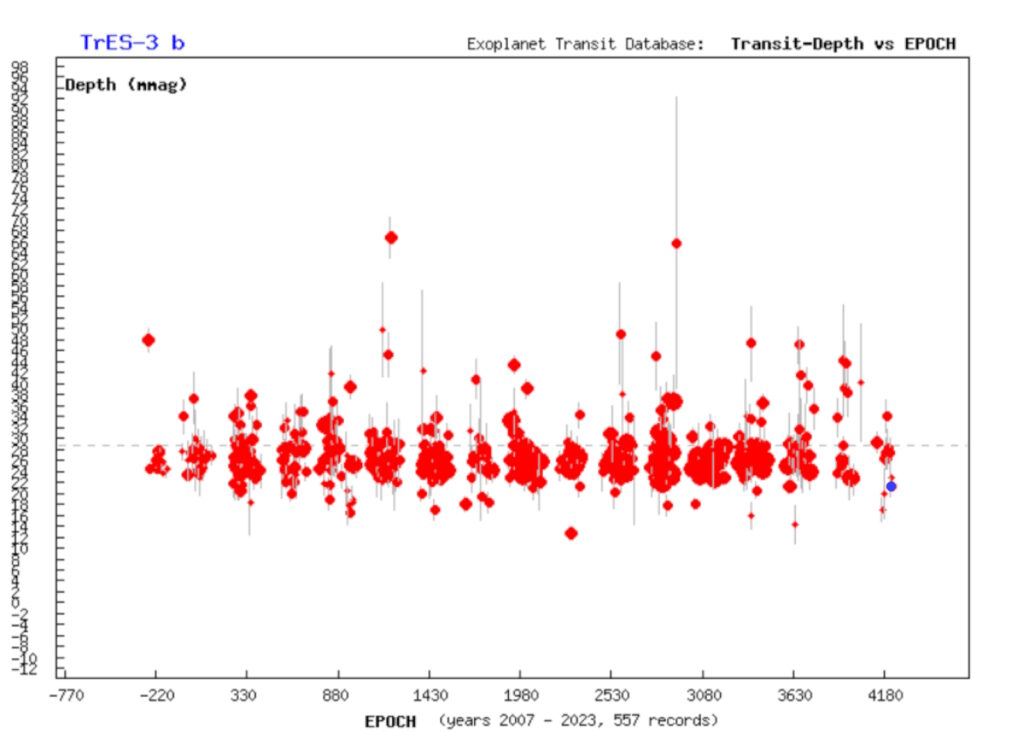Dr. Gerold Holtkamp, June 24, 2023
The transit light curve of the exoplanet TrES-3 b was recorded and measured on May 27th and 28th 2023. The method used and the specific observation conditions are explained. The results are presented and discussed based on an evaluation in the international Exoplanet Transit Database (ETD). The own result is a contribution in the context of so-called citizen science for further exploration of exoplanets.
The transit method for detecting exoplanets
Less than 500 years ago, Giordano Bruno was burned by the Catholic Church for his claims that there very well existed other worlds with other intelligent beings than just Earth. Today - but only for a little more than 30 years - it can be proven that other stars also have planets.
There are different ways to do this. The most important and also accessible to amateurs is the so-called transit method. This exploits the fact that in certain constellations a planet passes in front of its parent star for us observers on Earth. So there is a kind of partial eclipse, which weakens the light of the parent star, but only very slightly. The fading depends on the relative size of the exoplanet to its parent star. Nowadays, attenuations in the range down to 5 mmag are also accessible to amateur astronomers. It's a challenge though. The measurable "darkening", i.e. the duration of the transit ranges from a few minutes to many hours, depending on the orbital period of the planet. The measurement can therefore extend over several hours, with measurements also being taken in the time before and after the darkening (approx. 1 hour each).
The star TrES-3 and its planet TrES-3 b
TrES-3 (GSC 03089-00929)* is a spectral type G variable star. Its surface temperature is 5720 K. It has 0.924 times the mass and 0.813 times the radius of the sun. So it is similar to our sun. However, it is 757 light-years (Lj) away from us, which is why it only appears to us as 12.4 mag (V) bright star. [1] [1]
Its planet, the exoplanet TrES-3 b, was discovered in 2007. It orbits its parent star at a distance of just 3.38 million km, which results in a surface temperature of 1555 K. Its orbital period is 1.3 days. It has 1.9 times the mass and 1.3 times the radius of Jupiter. [2] [3]
If so much is known about this star and its planet, why is it still interesting to make transit measurements? On the one hand, there is the joy of being able to prove, as an amateur, that there are other stars outside of our solar system that are also orbited by planets. On the other hand, scientific investigations are carried out to determine whether there are indications of other planets in this system that have not yet been discovered via changes in the transit duration and the transit center (so-called timing variations) in the transit measurements. Their gravitational influence would bring about such changes. With a large number of measurements over a longer period of time, such changes should be detected. Since the large professional observatories do not provide sufficient measuring time for such measurements, which last at least three to four hours, amateurs have a chance here. Even if their devices mostly don't have the quality of the professional ones, this shortcoming is made up for by their much larger number. The use of such data in scientific work is z. B. described in [4]. [4] beschrieben.

TrES-3 is in the constellation Hercules as seen from Earth. The star field visible to the camera in the telescope is shown below. A few objects of this two-dimensional projection are briefly described. It turns out that apparently neighboring objects are not neighbors at all. The two galaxies MCG+06-39-023 and UGC 11015 are likely to be particularly far away. Apart from the morphological description, no further data were found. Based on their apparent size, both are likely to be many millions of light-years away. The stars HD 163128 with a distance of 1429 light years and HD 163095 with a distance of 1624 light years are already quite close to us, although much further away than TRES-3. HD 162752 with a distance of 339 LY is closest to us.

The Measurement
The Transit Finder from Swarthmore College in Pennsylvania, USA was used to plan the measurement [10]. Here you can find all the data you need to plan a transit measurement.

The measurement consisted of 69 individual recordings of the star field with the object to be examined. It was important to ensure that the individual stars were not overexposed, i.e. that the camera worked in the so-called linear range of its sensitivity. As a result, the different recordings and thus the brightness of the stars remained comparable. The Muniwin 2.1 software was used for the evaluation/photometry. All recordings were adjusted with 5 flat, dark and bias recordings each. In order to compensate for fluctuations in atmospheric transmission, the brightness of the target star was always measured in relation to several reference stars.
The recordings were made on 27./28. 5. 2023 from 21:25 UTC to 1:04 UTC. The moon was 53% exposed and 95° away from the object of investigation. Nautical twilight ended at 21:23 UTC and began at 1:26 UTC. The measurements were therefore carried out in sufficient darkness. The moon did not shine directly into the tube. The air temperature was 4°C.
The apparatus structure:
elescope: Newtonian 250mm aperture, 1200mm focal length
Filter: L (Antlia)
Camera: OHY268M (QHYCCD)
Chiptemperature: -15° C
Gain: 60
Offset: 20
The results
The measurements obtained were submitted to the Exoplanet Transit Database (ETD) of the Czech Astronomical Society [11]. Here, after checking the results, you get a diagram, an additional compensation curve and values derived from your own measurements for the examined exoplanet.

The following data for the exoplanet TrES-3 b were determined by ETD from the measured transit light curve. The catalog values of the Transit Finder are in square brackets:
- Mitte der Transitkurve: 23:35 [23:35] UTC
- Tiefe der Transitkurve: 0,0218 +/- 0,0015 [0,0274] mag
- Dauer des Transits: 80,7 +/-4,3 [85] Minuten
Folgende Parameter von TrES-3 b wurden von ETD aus den gemessenen Daten ermittelt. In eckigen Klammern stehen die Katalogwerte von ETD:
- R (TrES-3 b): 1,119 +0,037 -0,039 R(Jupiter) [1,305 +/- 0.09 R(Jupiter)
- Orbital inclination: 82,18 +0,50|1,93 -0,45|1,77° [82,15 +/- 0,21°]
ETD used: R (star) = 0.813 +/- 0.027 R (sun), orbital radius = 0.0226 +/- 0.0013 AU, orbital period = 1.3062 days



Discussion of the results
The middle of the transit was hit very well. The measured duration of the transit still agrees with the catalog value within the error limits. However, the measured depth of the transit differs greatly from the catalog value, which is then also reflected in the derived radius of the exoplanet. One reason for this may be that during the 3.5-hour measurement, dew formed on the primary mirror from about the second half of the measurement, which could be seen in the images brightening.
Overall, the results obtained can be used in databases that are open to amateurs and accessed by scientists. In the publication by Vineet Kumar Mannaday et al [4] already mentioned above, measurements from ETD are used in addition to other data.
In ETD, a quality grade of 3 was achieved for our own measurement (evaluation runs from 1 to 5, with 1 meaning very good and 5 meaning very bad.). A further improvement in the observation technique and conditions (as far as possible) is of course desirable. Possible improvements are prevention of fogging of the primary mirror and measurements without the moon. The influence of disturbing light sources, especially changing ones, will probably never be completely successful due to the urban observation location.
The results were also uploaded to the American Association of Variable Star Observers (AAVSO) database. [12]
___________________________________________________________________________________________________________________________________________________
Sources:
[1] http://simbad.cds.unistra.fr/simbad/sim-id?Ident=1SWASP+J175207.01%2B373246.3&NbIdent=1&Radius=2&Radius.unit=arcmin&submit=submit+id
[2] http://exoplanet.eu/catalog/tres-3_b/
[3] https://exoplanetarchive.ipac.caltech.edu/overview/TrES-3%20b#planet_TrES-3-b_collapsible
[4] Revisiting the Transit Timing Variations in the TrES-3 and Qatar-1 Systems with TESS Data,
Vineet Kumar Mannaday et al, The Astronomical Journal, 164:198 (20pp), 2022 November
https://iopscience.iop.org/article/10.3847/1538-3881/ac91c2/pdf
[5] http://simbad.u-strasbg.fr/simbad/sim-id?Ident=MCG%2B06-39-023&NbIdent=1
http://ned.ipac.caltech.edu/byname?objname=UGC+11015&hconst=67.8&omegam=0.308&omegav=0.692&wmap=4&corr_z=1
[6] http://simbad.u-strasbg.fr/simbad/sim-id?Ident=UGC%2011015
http://ned.ipac.caltech.edu/byname?objname=UGC+11015&hconst=67.8&omegam=0.308&omegav=0.692&wmap=4&corr_z=1
[9] http://simbad.u-strasbg.fr/simbad/sim-id?Ident=%40750100&Name=HD%20%2032147&submit=submit
[10] https://astro.swarthmore.edu/transits/transits.cgi
[11] http://var2.astro.cz/EN/tresca/index.php?lang=en
Annotation
* TrES stands for "Trans-Atlantic Exoplanet Survey". It is an international project for the study of exoplanets, in particular with the aim of discovering and characterizing planets orbiting other stars than our sun. TrES-3 b is one of the exoplanets discovered as part of the TrES project.